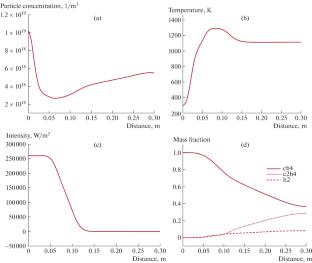催化纳米粒子存在时甲烷激光热化学相关非稳态问题的数学建模
IF 0.6
4区 数学
Q3 MATHEMATICS
引用次数: 0
摘要
摘要 针对亚音速气流中带有催化纳米粒子的激光热化学非稳态问题,开发了一种对物理过程进行分割的有限体积算法。模拟了在激光辐射下加热管道中的两相流动以及甲烷非氧化转化的自由基动力学。结果表明,管道出口处的甲烷转化率超过 60%,主要形成乙烯和氢气。本文章由计算机程序翻译,如有差异,请以英文原文为准。


Mathematical Modeling of Nonstationary Problems Related to Laser Thermochemistry of Methane in the Presence of Catalytic Nanoparticles
A finite-volume algorithm with splitting over physical processes is developed to model nonstationary problems of laser thermochemistry with catalytic nanoparticles in subsonic gas flows. Two-phase flows in a heated pipe with laser radiation and radical kinetics of nonoxidative methane conversion are simulated. It is shown that the conversion of methane at the outlet of the pipe is more than 60% with predominant formation of ethylene and hydrogen.
求助全文
通过发布文献求助,成功后即可免费获取论文全文。
去求助
来源期刊

Doklady Mathematics
数学-数学
CiteScore
1.00
自引率
16.70%
发文量
39
审稿时长
3-6 weeks
期刊介绍:
Doklady Mathematics is a journal of the Presidium of the Russian Academy of Sciences. It contains English translations of papers published in Doklady Akademii Nauk (Proceedings of the Russian Academy of Sciences), which was founded in 1933 and is published 36 times a year. Doklady Mathematics includes the materials from the following areas: mathematics, mathematical physics, computer science, control theory, and computers. It publishes brief scientific reports on previously unpublished significant new research in mathematics and its applications. The main contributors to the journal are Members of the RAS, Corresponding Members of the RAS, and scientists from the former Soviet Union and other foreign countries. Among the contributors are the outstanding Russian mathematicians.
 求助内容:
求助内容: 应助结果提醒方式:
应助结果提醒方式:


